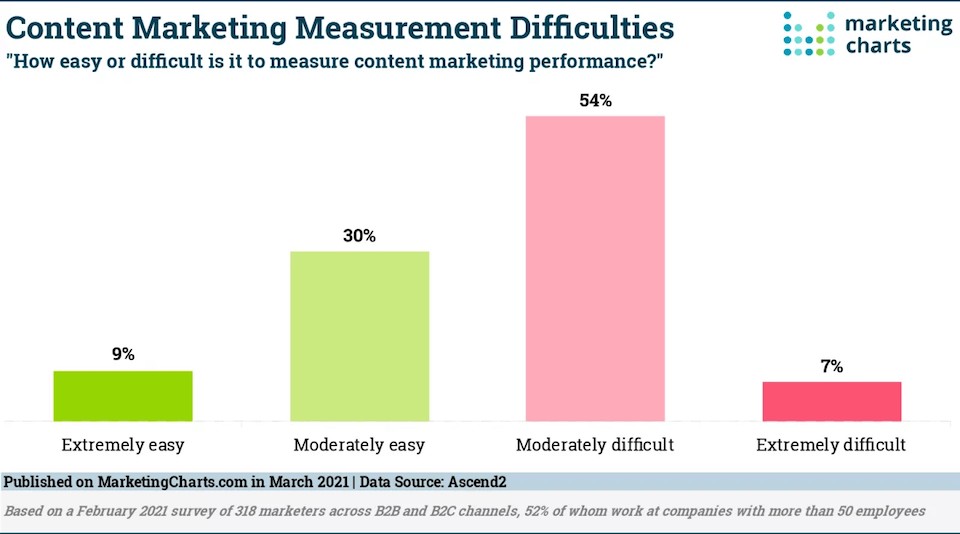
How to Measure Content Marketing ROI (With Real Metrics)
Nov 12, 2021|Read time: 12 min.
Key Points
- Content marketing ROI refers to the ratio between the profits and expenses of all of your content marketing activities.
- Calculating the ROI of content marketing helps you measure performance against your other marketing initiatives.
- Although hard data is important, there’s much more to determining the value of your content than comparing the dollars in vs dollars out.
Whether you manage a digital marketing budget, or you’re in charge of building a content team and reporting against department goals, it’s critical that you know how to accurately measure content marketing ROI.
Even if your content marketing goals are tied to ambiguous outcomes like brand awareness, you still need to see a return on investment in order to justify your spend. The problem is, it can be a convoluted process to measure the full value of content marketing. As a result, business leaders often severely undervalue the impact of their content efforts.
Obviously, your marketing team can track the click-through rate on email marketing campaigns, measure referral traffic from byliness, and track subscriptions and opt-ins from landing page CTAs. Those metrics are easy to collect and measure using a simple dashboard.
But, what about comparing the lifetime value of new customers acquired through content marketing vs paid advertising? Or, the impact of podcasts on brand awareness? How about the amplified visibility that search engine optimization brings to ecommerce product pages and blog posts?
As you’re aware, it can be difficult, if not impossible, to fully capture the ROI of your content marketing efforts. However, you should still consider as many of these factors as possible when comparing the channels and tactics within your marketing mix.
In this post, I’ll cover the basics of content marketing ROI, how to calculate ROI, and specific metrics you should measure.
What is content marketing ROI?
Marketing term
Content Marketing ROI
Content marketing ROI is the amount of revenue gained from content marketing compared to how much it cost to create and distribute that content.
We calculate content marketing ROI the same way we calculate SEO ROI or marketing ROI. It’s a simple ratio between the profits and expenses of all of your content marketing activities. Understanding this ratio helps you more effectively allocate budget to reach your marketing goals.
For instance, if you spend $10,000 on a content marketing campaign and it generates $20,000 in revenue, your ROI is 100%. To be clear, there is more to content marketing ROI than simply how much revenue it generates.
A particular piece of content, for example, might be one of several customer touch points that ultimately leads to a sale. So, it is important to measure ROI within the context of your other digital marketing strategies.
However, if your content marketing produces no significant ROI, it’s critical to reevaluate your methodology for measuring its effectiveness as well as your execution.
Brands generally believe that a great content strategy is valuable. In fact, Content Marketing Institute (CMI) found that 49% of respondents had used content marketing successfully in 2020. But, there’s a difference between trust and proof.
There is no denying that great content can make a positive impact on your business. But, understanding what content is making that impact, and how great the results are, allows you to replicate your success!
Content Strategy Playbook
The Fortune 500 CMO’s guide to content strategy.
How to calculate content marketing ROI
You can calculate the ROI on your content marketing in four simple steps.
Step 1: Calculate the cost to create the content
First, determine the costs to actually produce your content. This needs to include all associated costs, such as writing, design, video, audio, outsourced tasks, specialized tools, etc.
For example, creating a blog post often involves:
- Keyword research
- Writing
- Editing
- Image design
- Supplemental video creation
- On-page SEO
The total cost needs to include everyone who worked on these tasks, as well as any tools used to perform them.
Value of Organic Search White Paper
See how an investment in organic search delivers ROI that compounds over time.
Step 2: Determine the amount spent to distribute the content
Next, you need to determine the amount you spent distributing your content. Total up the costs of tools, advertising, or services used to create and promote the content.
Step 3: Determine how much in sales were received from your content
The third step is to calculate how much revenue your content generated. This can be a bit complicated at times since there isn’t always a clear connection between a specific piece of content or a content program overall, and a sale.
We’ll talk about the various metrics you can use to measure content marketing ROI in a bit. For now, let’s assume you already know the total sales attributed to your content.
Here’s an example of what that could look like.
Step 4: Calculate your ROI
The content marketing ROI formula is simple. Take your return, subtract the amount you invested in it, divide by the investment, and multiply by 100:
((Return – Investment) / Investment ) * 100
This formula will provide you with your ROI as a percentage. For example:
- Return = $5,000
- Investment = $1,000
- $5,000 – $1,000 = $4,000
- $4,000 / $1,000 = 4
- 4 * 100 = 400% content marketing ROI
How can you know if the time and money you spent on content marketing was worth it? Content marketing is a long term strategy that will rarely see immediate results. This is why measuring ROI can be so challenging. While there are no hard and fast rules, comparing the ROI from your content marketing to that of your other marketing efforts over an extended period of time can give you a good sense of its effectiveness.
Regardless of the short term, over the long term the ROI can be amazing.
Capgemini is a great example. They were facing a lack of ROI on existing marketing channels and feared their brand was trailing the competition. This prompted them to take a gamble on content marketing that was more storytelling in nature and answered potential customers’ questions.
That gamble paid off with the first year resulting in a million new visitors to their website and the addition of 3-4,000 new followers on LinkedIn being added each week. By the end of year two, it is estimated that their metrics increased 8x over year one.
Financial Services Market Report
See which banks have the most Google organic market share.
Why it’s hard to measure content marketing ROI
A survey on MarketingCharts.com shows that 54% of marketers find measuring the effectiveness of their content marketing “moderately difficult”. In another survey it was found that only 43% of B2B marketers even measure content marketing ROI.
So, if you find it difficult to determine the impact content has on revenue, you aren’t alone.

Marketing vehicles like PPC make it easy to calculate ROI. But, content marketing is more difficult to measure. In fact, Tim Soulo of Ahrefs made a good point about tracking the ROI of content marketing.
But what about actually MEASURING that ROI?
— Tim Soulo (@timsoulo) March 23, 2021
Well.. you can indeed measure some of the things that I mentioned.
Like how many leads your content is bringing or how reading a certain article influences your LTV.
But calculating the TOTAL ROI of content marketing?
Impossible.
But your content marketing should be measured in some way.
Determine what your key content metrics are and then use them to evaluate whether the content you’re creating is moving the needle for your company. By measuring your content marketing ROI, you’ll start to see patterns emerge that can help refine your digital marketing plan. For example, will your audience respond better to a live webinar or a recorded video?
With time it will become easier to determine what works and what doesn’t. Then you can use this information to better allocate your resources toward content that truly drives results.
Content marketing metrics to measure
Most folks define content marketing success by the financial impact it has on your bottom line. But, there are so many other ways to measure content performance.
Measuring different data points can inform whether you use multi-touch attribution or another model in your analytics tool. This, in turn, can feed back into your ROI calculation which helps you better understand how impactful your content is throughout the customer journey.
Search engine visibility
Increased search engine visibility is an ideal way to measure the ROI of content marketing. It’s the direct result of both ranking higher for keywords and ranking for more keywords. That’s because you’re actually competing for clicks in the SERPs. And the higher you rank in Google, the more available clicks you’ll win.
So, although you could measure specific keyword rankings, your organic search visibility score is a broader lens through which to view your overall content performance.
Furthermore, because visibility is more closely tied to market share and revenue, it’s a better metric to share if the CMO or CEO ever asks you, “what is the ROI of content marketing?”
Brand awareness
One of the most common goals of content marketing is to increase brand awareness. The more someone knows, likes and trusts your brand, the more likely they are to become a customer.
The more someone likes and trusts your brand, the more likely they are to become a customer.
here are a number of ways you can measure brand awareness, including:
- Brand-related search volume
- Social media following
- Direct visits to your website
- Media mentions
A noticeable increase in any of these things following a content marketing campaign indicates that brand awareness has increased and the campaign was successful.
Website traffic
A common goal of content marketing campaigns is to increase website visitors. After all, if no one is seeing your content there is no way to make a sale! However, it’s critical that you analyze traffic data in conjunction with other key performance indicators (KPIs) to ensure that your website gets the right traffic.
For example, if a particular page generates significant traffic but none of those visitors ultimately convert to leads or sales, then the traffic isn’t doing you much (or any) good. You need to make sure the right people are coming to your site and that these visitors’ actions align with your overall business goals.
It’s critical to understand where your website visitors come from and how they interact with specific content. As a result, you’ll know which of your content marketing efforts generate conversions and qualified leads.
If your website traffic is increasing but your conversion rate remains low, there’s a good chance you’re targeting the wrong audience or that your content doesn’t speak to the pain points and desires of your audience.
Revisit your customer personas, buyer’s journey, and empathy map to ensure that you truly understand your customers.
Backlinks
A backlink is when another website links to your content. This signals that your content is valuable, authoritative, and worth sharing with others.
Backlinks also play a significant role in SEO, helping to increase your content’s visibility on search engines, which leads to more organic search traffic.
If you publish two pieces of content on your website and one generates a significant number of backlinks and the other doesn’t, use a tool like Ahrefs to determine where the backlinks to the first piece are from.
This can provide valuable insights into what content your audience considers to be valuable and why they value it. This can then shape future content marketing decisions.
Engagement
Engagement metrics reveal how well your content resonates with your audience. Afterall, traffic means nothing if your visitors don’t take action at some point.
Website analytical tools help you understand how visitors interact with your content. They can reveal clicks, scroll depth, pageviews, video views and more.
However, you’ll need to measure different engagement metrics for different types of content.
- For blog posts, look at time on page, bounce rate, page views, scroll depth, and social media shares.
- To track video engagement, measure view duration and total number of views.
- For social media posts, evaluate impressions, likes, re-shares, comments, etc.
These metrics . Do they abandon a blog post after reading just a few paragraphs? Does the average viewer only watch the first minute of a video?
Higher levels of engagement mean that the content resonates with your target audience and that your content marketing efforts are trending in the right direction.
Qualified leads
One of the most common ways to evaluate the success of a content marketing campaign is whether it generates leads.
Attracting the right audience starts with great content that’s optimized for organic search. However, to convert visitors into leads, you’ll need lead magnets and a well planned sales funnel. Start at the top of the funnel with awareness-building content. Then, create gated content to capture contact information. Finally, create engaging email campaigns to push visitors deeper into the conversion funnel.
Keep in mind however, where the content sits in the context of your marketing funnel. The top of the content marketing funnel is less likely to generate leads. However, it serves as an entry point to guide visitors further down the funnel.
If you understand how lead generation works, then you can measure content marketing ROI at a much more granular level.
Sales and revenue
Though your content may not immediately produce a sale, it should help your audience advance through the customer journey.
This might include:
- Subscribing to your email newsletter
- Engaging with another piece of content
- Opting in to receive your downloads
Tools like Google Analytics can provide clarity regarding which content and channels are assisting with conversions, even if they weren’t the final touchpoint before a sale. If a piece of content plays little to no role in moving prospects toward a conversion, it doesn’t matter how much traffic it gets.
Non-performing content should be improved or removed altogether.
It’s also important to track the performance of content over time. If your content starts to generate fewer conversions or traffic, it is a sign that something has changed since you published it. Your target audience may have shifted, making the content less relevant, or the information might be outdated.
Brand affinity and loyalty
Perhaps the hardest content marketing ROI to measure is improved brand sentiment. However, as your sales team can attest, any improvement in this metric translates directly to more revenue.
Current customers are always more receptive to your marketing efforts than new ones. They’re also more likely to share high-quality content and engage with your brand online. This can lead to positive brand exposure for you and more organic traffic and leads.
To measure brand affinity and loyalty, first segment your audience into new and existing customers. Then, analyze how your existing customers engage with your content.
Do they consistently read and share your blog posts? How far do they get when watching videos? Do they share your content on social media and click on your emails? These data points reveal whether your existing customers find your content valuable.
In addition, you can track and measure NPS scores to find out if your customers would recommend your business.
Fuzzy numbers are okay
When you’re responsible for allocating millions of dollars in marketing budget to various activities, you should usually use hard data and facts. For example, how does your content return on investment compare to the ROI of Google Adwords, email marketing, or non-digital channels like direct mail? That’s especially important if your primary objective is conversions.
However, don’t be afraid to use fuzzy math if your marketing goals are centered around brand awareness.
Remember, content marketing ROI isn’t always about dollars in vs dollars out. And brand-related goals are incredibly hard to quantify. Yet, improved brand sentiment can have a massive impact on your business’s ability to win in the marketplace.
So, use hard numbers as much as possible, but don’t be afraid to put your finger on the scale if need be from time to time as well.
Fortune 500 Enterprise SEO Playbook
Discover how enterprise brands can create content that builds authentic audience connections.




